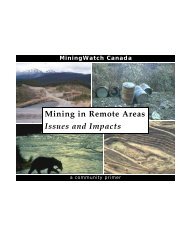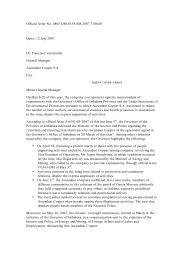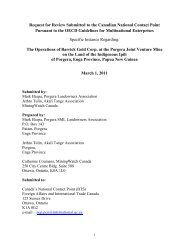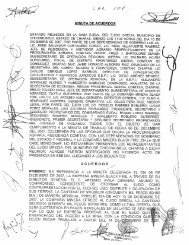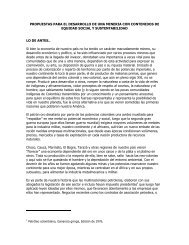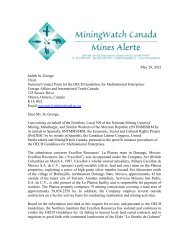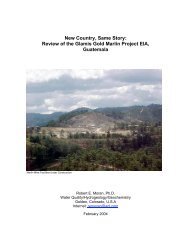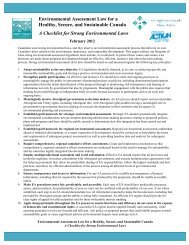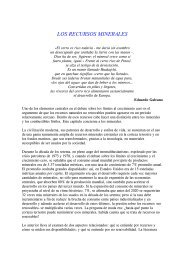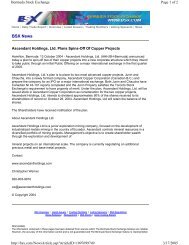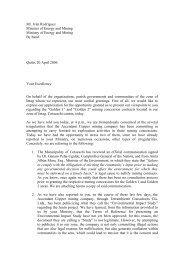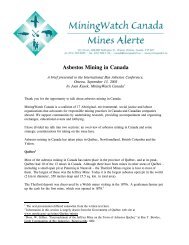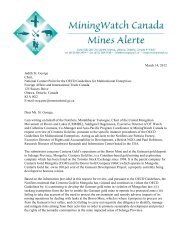Environmental Aspects of Phosphate and Potash Mining
Environmental Aspects of Phosphate and Potash Mining
Environmental Aspects of Phosphate and Potash Mining
- No tags were found...
Create successful ePaper yourself
Turn your PDF publications into a flip-book with our unique Google optimized e-Paper software.
<strong>Environmental</strong> <strong>Aspects</strong> <strong>of</strong> <strong>Phosphate</strong> <strong>and</strong> <strong>Potash</strong> <strong>Mining</strong>These are complex, interlinked issues. “Sustainabledevelopment” has been proposed as a holisticapproach for dealing with these complexities.Sustainable development integrates economic, environmental<strong>and</strong> social considerations in order toimprove the lives <strong>of</strong> the current generation <strong>and</strong> ensurethat future generations will have adequate resources<strong>and</strong> opportunities.Over recent decades, public awareness <strong>and</strong> concernhas grown, as has knowledge <strong>of</strong> the effects <strong>of</strong> ouractivities on the environment. The 1992 UnitedNations Conference on Environment <strong>and</strong>Development (UNCED) held in Rio de Janeiro, Brazilresulted in Agenda 21, an action plan for the implementation<strong>of</strong> sustainable development throughout alllevels <strong>of</strong> society. Agenda 21 identified the global economic,environmental, <strong>and</strong> social issues to beaddressed <strong>and</strong> provided a detailed framework formoving society towards sustainable development.In the case <strong>of</strong> phosphorus <strong>and</strong> potassium, althoughthe best quality <strong>and</strong> most easily accessible deposits aremined first, the total available resources are sufficientfor hundreds or thous<strong>and</strong>s <strong>of</strong> years. But no mineralresource is infinite <strong>and</strong> the efficient extraction <strong>and</strong> use<strong>of</strong> phosphate <strong>and</strong> potash are an important contributionto a certain degree <strong>of</strong> sustainability.The mining industry has an important role to play inthis respect: Rehabilitation allows the l<strong>and</strong> disturbed by theextraction <strong>of</strong> the mineral resource to be returnedto the pool <strong>of</strong> l<strong>and</strong> available for other uses; Optimization <strong>of</strong> the recovery <strong>of</strong> the resource maybe encouraged through the use <strong>of</strong> the most efficienttechniques <strong>and</strong> technologies available; Any unrecovered resources can be left in a conditionsuch that possible future improvements intechnological capability <strong>and</strong> economics will beable to access <strong>and</strong> recover the resource; <strong>and</strong> The development <strong>of</strong> more efficient mining <strong>and</strong>processing methods <strong>and</strong> techniques can extendcurrent resource life, <strong>and</strong> help to recover, recycle<strong>and</strong> reuse minerals.These principles have application across all sections <strong>of</strong>the mining industry, including that <strong>of</strong> the phosphaterock <strong>and</strong> potash mining industry. The mining industryhas responded to the sustainability issues that arechallenging it on a number <strong>of</strong> fronts. Several <strong>of</strong> themare discussed in this report.<strong>Mining</strong> Members <strong>of</strong> the World Business Council onSustainable Development (WBCSD) established theGlobal <strong>Mining</strong> Initiative (GMI) in 1998. The GMI,representing some <strong>of</strong> the worlds leading mineral <strong>and</strong>mining companies, was established to provide leadership<strong>and</strong> direction for the future development <strong>of</strong> themining industry in a sustainable manner. To this end,the GMI approached the International Institute <strong>of</strong>Environment <strong>and</strong> Development to commission the<strong>Mining</strong>, Minerals <strong>and</strong> Sustainable Development(MMSD) project, to determine how mining can mosteffectively contribute to sustainable development.Regional groups have been established, stakeholdersengaged <strong>and</strong> consulted, issues identified, <strong>and</strong> researchcommissioned to determine how the services <strong>of</strong> themining industry can be orientated to sustainabledevelopment <strong>and</strong> develop an action plan to guide theindustry in coming decades. This action plan is to beimplemented by the new International Council on<strong>Mining</strong> <strong>and</strong> Metals (formally The InternationalCouncil on Metals <strong>and</strong> the Environment).National mining associations have developed <strong>and</strong> disseminatingcharters or voluntary codes <strong>of</strong> practice toimprove the level <strong>of</strong> environmental management. Anexample <strong>of</strong> this is the Australian <strong>Mining</strong> IndustryCode for <strong>Environmental</strong> Management developed bythe Minerals Council <strong>of</strong> Australia (see Appendix C).This voluntary code has been widely adopted by miningcompanies within Australia. These are required topublish public environmental reports to demonstrateprogress on the implementation <strong>of</strong> the code's principles.The World Bank has been actively developing miningsector capacity in developing countries. Programshave focused on drafting mining legislation, buildingup environmental management capabilities <strong>and</strong> creatingincentives for private investment.NGO co-operation with the mining industry hasincreased at local <strong>and</strong> global levels in recent years. TheWorld Wide Fund for Nature (WWF) has been activein developing relationships with the mining industryto foster improved performance. The WWF has beenleading the development <strong>of</strong> an independent miningcertification system in partnership with Placer Dome(Australia). This system is based on the ForestStewardship Council (FSC) model that has beeneffective in fostering improvement <strong>of</strong> the environmentalperformance <strong>of</strong> the forestry industry.



